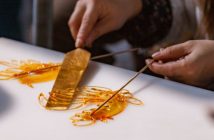There’s a whole lot to know if you’re going to celebrate Chinese New Year properly, and this year I plan on doing everything by the book and sticking as close to tradition as possible, partly to teach my little girl this side of her heritage and partly to finally satisfy the curiosity I’ve had for it all these decades. So, join me as I explain every Chinese New Year tradition that’s about to take over the city.
Search #JingkidsCNY to find more articles on this topic.
Chinese New Year is a time of joy, family reunions, and vibrant celebrations. In Beijing, this holiday is marked not only by colorful festivities but also by a rich culinary tradition. The city comes alive with the aroma of special dishes that have been passed down through generations, each holding symbolic significance.
The culinary traditions of Chinese New Year vary between Northern and Southern China, reflecting the diverse cultural and regional influences across the vast country.
In Northern China, particularly in cities like Beijing, dumplings take center stage during the celebrations. Families come together to make them with their family’s signature stuffing, representing prosperity. Additionally, steamed fish (qingzheng yu) is a common feature on Northern Chinese New Year tables, symbolizing abundance and unity.
On the other hand, Southern China, exemplified by cities like Guangzhou, embraces a sweeter palette. Sticky rice cake (nian gao) is a beloved delicacy, emphasizing the wish for growth and good luck. Additionally, Southern Chinese New Year feasts often include various sweet treats, reflecting the region’s penchant for desserts. While both regions share the joy of family reunions and the symbolism behind certain dishes, the nuances in flavors and ingredients showcase the rich diversity within China’s culinary tapestry. So let’s take a look at what you’re about to feast on in Beijing.

Dumplings (Jiaozi)
No Chinese New Year celebration is complete without the presence of jiaozi. In Beijing, families often gather to make these dumplings together on CNY eve, turning the activity into a bonding experience. Jiaozi symbolize wealth and prosperity, making them a must-have dish for the New Year.
Nian Gao (Sticky Rice Cake)
Nian gao, or sticky rice cake, holds a special place in Beijing’s New Year celebrations. This sweet and chewy treat is believed to bring good luck and growth in the coming year. Often sliced into rounds or squares and pan-fried, nian gao is enjoyed for its symbolic significance as the Chinese word for sticky (黏 nián) sounds like year (年 nián), signifying the promise of a better and more prosperous year ahead.
Qingzheng Yu (Steamed Fish)
Steamed fish, known as qingzheng yu, is a staple on the Chinese New Year menu in Beijing. The Chinese word for fish, 鱼 yú, sounds like the word for surplus (余 yú), symbolizing abundance and prosperity. Families often choose a whole fish, representing unity and completeness. The fish is typically steamed and served with soy sauce, ginger, and scallions, creating a flavorful and auspicious dish. This dish is incredibly delicious and surprisingly simple to make. Stay tuned, we’ll be sharing a recipe for this in the coming days.
Cabbage
Chinese cabbage (baicai) is often included in New Year’s dishes for its association with wealth and prosperity. The pronunciation of cabbage (白 bái) in Chinese is similar to the word for hundreds (百 bǎi) or “wealth.” Stir-fried baicai is a common dish during the festival, bringing not only a burst of color to the table but also a representation of financial success in the coming year.
Spring Rolls
Spring rolls are a symbol of wealth and prosperity due to their resemblance to gold bars. They are often eaten during the New Year festivities. Plus, they’re delicious and easy to make. We always have a packet of frozen ones in the freezer.
As Beijing welcomes the Chinese New Year, the city’s residents embrace a culinary journey that goes beyond mere sustenance.
Traditional foods not only tantalize the taste buds but also carry deep symbolic meanings, connecting families to their cultural heritage. From the auspicious jiaozi to the symbolic nian gao, each dish tells a story of hope, prosperity, and the promise of a bright future in the heart of the Chinese capital.
Images: Pexels, Bing




